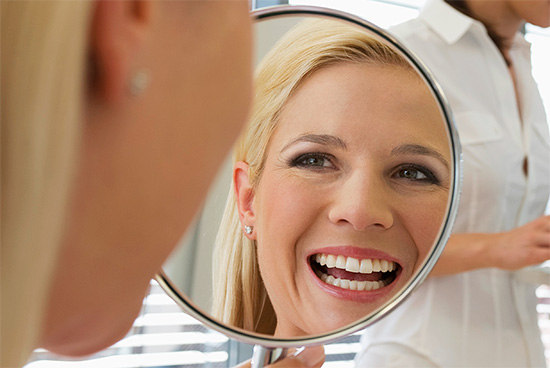
Generally speaking, all methods of teeth whitening can be divided into two large groups: professional and home. Moreover, the latter have become very popular today, since very few people like to go to the dentist once again, even if he is not going to drill anything and, even more, “tear out”.
However, before you start your way to a snow-white smile, it will be useful to first understand - what types of teeth whitening today exist, how do they differ fundamentally between themselves and which one is the most effective. In addition, in the pursuit of efficiency, we must not forget that many types of teeth whitening have a very negative effect on the state of the tooth enamel - and this also needs to be known in advance.
So if you are already going to smear something on your teeth, rub something with them, or pour hydrogen peroxide on them, then we suggest putting off your chemical experiments for a while and approaching the issue more systematically.
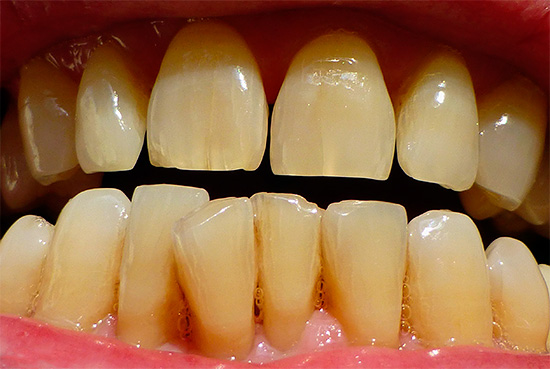
On a note
Today, there are such types of teeth whitening as mechanical, ultrasonic, laser, photo-whitening, intra-channel, and also bleaching with the help of pencils, cap, special strips, etc. For an untrained person, it may seem like a lot of ways to lighten the enamel, and that it is very difficult to understand all this.
In fact, everything is quite simple - all these methods of teeth whitening are inherently divided into chemical and mechanical.
Chemical teeth whitening is, simply put, the process of breaking colored organic compounds inside enamel with the help of special substances. In such cases, a chemical agent is always required that can destroy and discolor pigments (for example, oxidize them) that have appeared in the surface layer of tooth enamel over the long years of smoking, coffee abuse, strong tea, red wine, etc.
Mechanical teeth whitening is, in fact, professional oral hygiene, which many dentists do not even consider whitening (although the procedure gives a very pronounced visual effect). Imagine healthy white teeth, but covered with brown tartar and tinged stains.When all these undesirable deposits are mechanically removed, a person can again sparkle with a snow-white smile - but no one has whitened his own teeth (enamel).
Professional hygiene can involve ultrasonic whitening of teeth with the help of special devices and scalers, brushing your teeth with an Air-Flow machine, removing plaque with special pastes. The benefit of professional cleaning for an ordinary person is that for a relatively low price you can kill two birds with one stone: save your teeth from the traumatic gum stone and plaque that creates caries risks, and at the same time “lighten” your teeth to tone and more without direct impact on internal enamel structures.
Mechanical "whitening" of teeth: the principle of work
As noted above, mechanical teeth whitening is a way to lighten them, in which dental deposits (stones, plaque) are removed, which ultimately leads to the return of the natural color of teeth.
Often, those people who have grown for years on their teeth “raid smoker”, “coffee lover”, as well as conglomerates of stones (most often - on the lower front teeth) have long forgotten how their clean teeth should normally look like.In such cases, it is necessary to look not for peroxide-containing pencils or teeth whitening strips, but to focus primarily on professional oral hygiene - this will give a much greater effect.
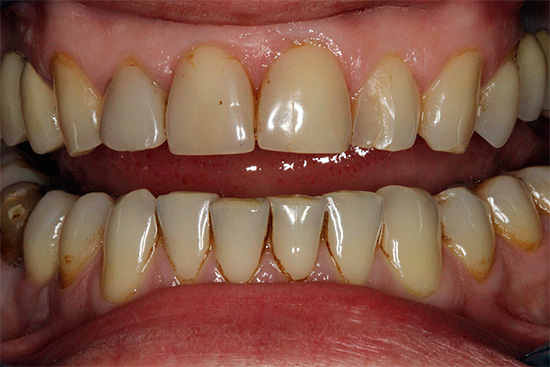
On a note
Among the mechanical methods of teeth whitening the most common today is the whitening of ultrasound. Despite the active use of Air-Flow devices for professional teeth cleaning, it is not yet possible to completely replace ultrasound. This is due to the fact that the Air-Flow apparatus does not remove tartar, although it partially affects their “loosening”.
An important property of mechanical bleaching is relative safety for tooth enamel, because the main impact is not on the enamel, but on the deposits on its surface.
However, it is not uncommon for there to be quite unpleasant consequences after the procedure. Due to the fact that the removal of tartar and plaque is often carried out against the background of periodontal diseases (for example, periodontitis), after the procedure, the cervical areas of the teeth are virtually unprotected.Before that, stones saved them from all kinds of irritants, and after they had their teeth removed, their teeth began to react with pains to cold, hot, etc. (This is confirmed by numerous reviews on the Internet).

This problem is most often solved by a dentist-periodontist who treats the underlying disease and simultaneously remineralizes and deeply fluorides hypersensitive enamel and (in some cases) root cement.
Below we will talk about the use of so-called whitening toothpastes, abrasive systems which, when misused, can cause considerable damage to the teeth due to mechanical abrasion of the enamel.
When is teeth whitening really needed and when is it unnecessary?
As practice shows, out of 10 people who turn to the dentist for the teeth whitening procedure, only about 6-7 of them will really be relevant, and for the rest it will either be ineffective (since the enamel is already close to the natural shade), or extremely unsafe.
Cases in which whitening will be effective:
- The presence of plaque and plaque;
- Changes in enamel color due to age;
- Acquired staining of hard tooth tissues in yellow or brown.
It is difficult to bleach:
- Congenital violation of the color of enamel (for example, the so-called tetracycline teeth);
- Gray staining;
- Change the color of the naked dentin.
Staining on the background of plaque and tartar is eliminated by mechanical types of bleaching, and the "internal" - chemical.
Ultrasonic whitening
Mechanical teeth whitening by ultrasound allows you to remove over-and subgingival dental calculus from all surfaces of the teeth using ultrasound machines and scalers. In addition, ultrasonic whitening allows you to clean the so-called “smoker plaque”, which is almost impossible to remove with home or professional brushes.
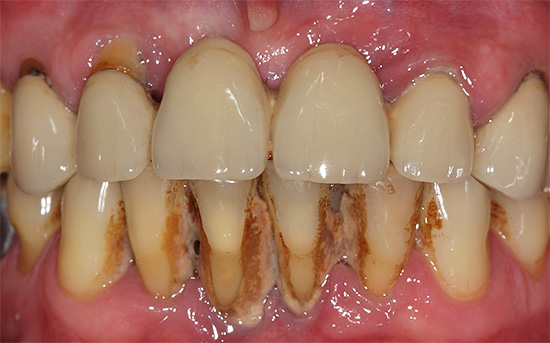
Due to ultrasonic vibrations at the end of a special tip, the structure of dental plaque and stone is mechanically destroyed, as well as its “sticking” from the enamel surface. If the basic instructions of professional oral hygiene are followed by ultrasound, the enamel is not injured, and there are usually no negative consequences from this type of bleaching.
When performing ultrasonic cleaning of teeth through the tip of the tooth water is supplied: it is necessary to ensure the safety and effectiveness of the procedure. Water helps to prevent overheating of the tooth (this would lead to necrosis of the pulp), and also creates vortex flows due to oscillatory movements of the tip, which improves the detachment of tartar and plaque.
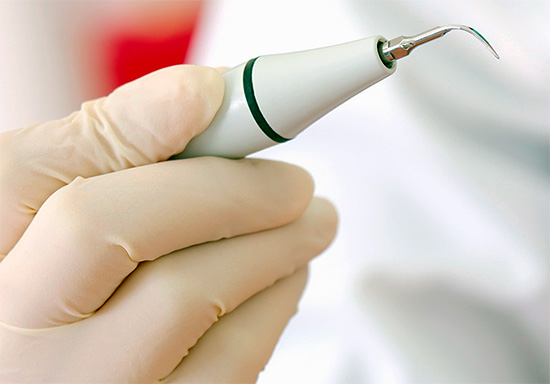

It is interesting
Ultrasonic toothbrush is quite suitable for home mechanical teeth whitening. The principle of its operation is approximately the same as in the case of the ultrasonic bleaching method, but not as broad as in the dentist’s chair.
The power of ultrasonic vibrations in such brushes is reduced - adapted for safe home use. As a result, an ultrasonic toothbrush makes it possible, albeit in a gentle way, to effectively remove plaque. However, it should be borne in mind that such brushes are not recommended for people with a pacemaker, as well as for pregnant women. Their use is limited when braces, veneers, crowns, and a large number of fillings are present in the oral cavity (due to the possible risk of "dislocation" of their ultrasonic vibrations).
Air-Flow Technology
The essence of Air-Flow technology is the mechanical action on an object (tooth surface) of a jet of air, water and ordinary baking soda released under high pressure. Thus, inside the Air-Flow machine is sodium bicarbonate powder (ordinary baking soda, which in this case is used as an abrasive) and air-water channels.
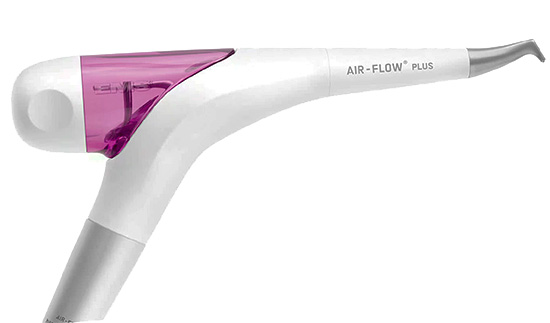
Mixing of water and soda occurs closer to the working part (tip) of the apparatus. The device is fixed in the socket of the unit of the dental unit, and under high pressure, water mixed with powder is thrown onto the surface of the tooth enamel, clearing it in seconds even from the densest plaque.
The convenience of whitening teeth with the help of Air-Flow is not only in the speed of processing a single tooth, but also in the quality of such treatment. The jet released from the tip of the apparatus easily penetrates even into tight gaps between the teeth, cleans plaque under the gum, effectively cleans the teeth under structures, for example, under braces.
As a result, in about 30-40 minutes, you can get teeth of natural natural color cleared of plaque.
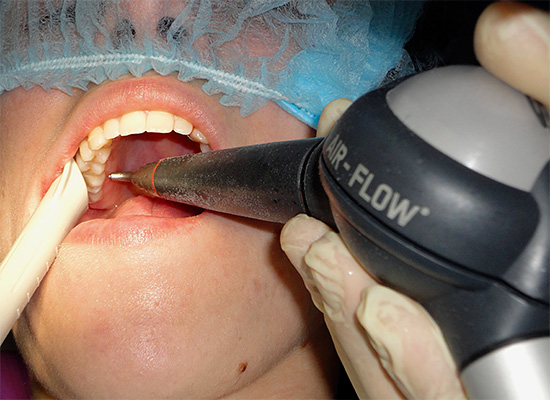
However, if you are going to whiten your teeth with the help of Air-Flow, then it should be remembered that, compared with ultrasound, this technology has a reduced effectiveness against tartar. In addition, with long-term retention of the tip of the apparatus near one tooth (more than 3-4 seconds), it is possible not only polishing the enamel, but also the appearance of its sensitivity after the procedure.
Additional mechanical methods of lightening enamel
Home-made methods of mechanical teeth whitening are perhaps the most popular among the population today, but at the same time not the most reliable and even often dangerous for the health of teeth.
Most often, in order to make the teeth whiter, people try to use the so-called whitening toothpastes. This is due to the fact that such an idea is very attractive - you brush your teeth, and every day they become whiter and whiter ...
However, many do not even think that as an active ingredient, abrasive powders are introduced into most of these pastes, which really actively clean the dental plaque, but at the same time can also seriously disrupt the structure of the enamel (they simply gradually erase this enamel).
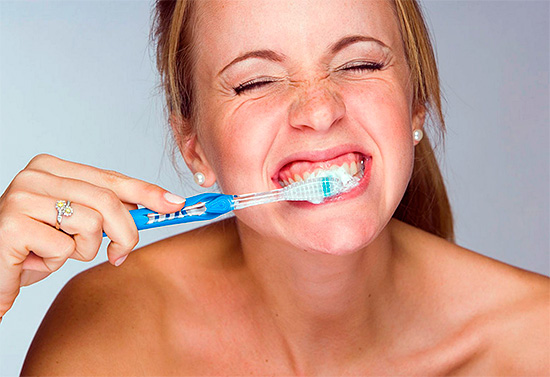
Uncontrolled long-term use of whitening pastes with a high abrasive effect almost always leads to an increase in the sensitivity of the teeth and even the appearance on them of areas of broken enamel in the form of depressions. Their localization is usually located in the cervical area of the tooth.
It is interesting
The abrasiveness index of toothpastes is characterized by a special index - RDA. For example, for ordinary pastes for daily use, this indicator may have the following values: about 20 for babies, 45 for schoolchildren, 65 for adults with sensitive teeth. The RDA index at the level of 75 - 150 is typical for whitening toothpastes with medium abrasiveness, and above 150 - these are highly abrasive pastes.
In the market of toothpastes can be found whitening toothpastes (for example, toothpastes from Thailand), in which this indicator is not indicated at all, and they include almost ordinary clay. Even not very long use of such pastes can have a very detrimental effect on tooth enamel.
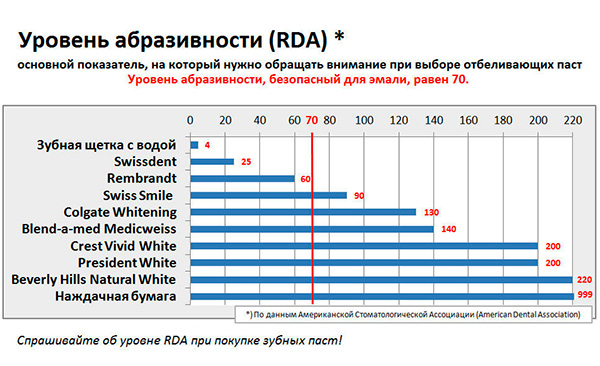
From the analysis of research results of whitening toothpastes, and even simply reading reviews from ordinary people, we can conclude that whitening toothpastes based on abrasives can help to cope with a soft and even hard plaque, but at some time can also spoil tooth enamel .
Whitening toothpastes based on chemicals (for example, enzymes) do not affect dense plaque with the force that real whitening requires, which means that the result of their use is questionable.However, there are quite a few defenders of this type of toothpaste, which note the whitening effect (but it does not take into account the fact that manufacturers often add abrasives to help a person cope with dental plaque using ordinary “friction”, and the presence of various exotics in the formulation pasta is in this case nothing more than a marketing ploy).
Currently, there are many adherents of teeth whitening with a brush that has hard bristles. The principle is as simple as the classic whitening toothpaste: to increase the efficiency of removing not only soft plaque from the teeth, but also the so-called “raid of a smoker”. As a result of the prolonged use of such a brush (even without whitening toothpaste), sometimes the teeth actually become whiter, and even more sensitive to all types of irritants (cold, hot) and, moreover, more fragile.
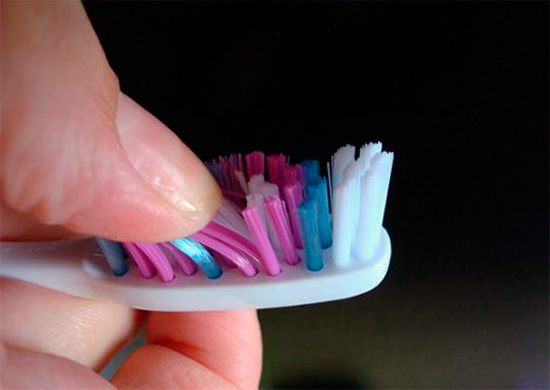
Therefore, dentists often find areas of pathological abrasion (wedge-shaped defects) in such experimenters in the cervical area of the teeth.It’s hard to imagine what will happen to such a tooth in a couple of months, if you add to the toothbrush with stiff bristles a whitening toothpaste of a high degree of abrasiveness ...
Chemical bleaching with different systems: pros and cons
Chemical teeth whitening existing popular systems can be divided into professional and home. Professional (otherwise - cabinet) whitening has a good whitening effect due to high concentrations of hydrogen peroxide or its derivatives, which are active components of gels applied to the tooth surface.
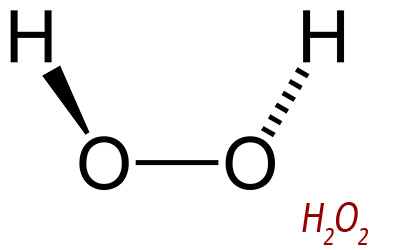
Modern technologies of chemical teeth whitening also involve the use of activators that initiate the decomposition of peroxides with the release of active oxygen. It can be:
- Heat;
- Ultraviolet radiation;
- Laser radiation;
and others. The use of activators enhances the whitening effect, and also reduces the time spent aggressive compounds in the oral cavity.
The most important advantage of room whitening (with any systems) is to achieve a well-pronounced whiteness of the teeth in more than 70-80% of cases, moreover in one visit. In certain situations, you can whiten your teeth not half a tone or a tone, but immediately 5-7 shades on a scale of colors.
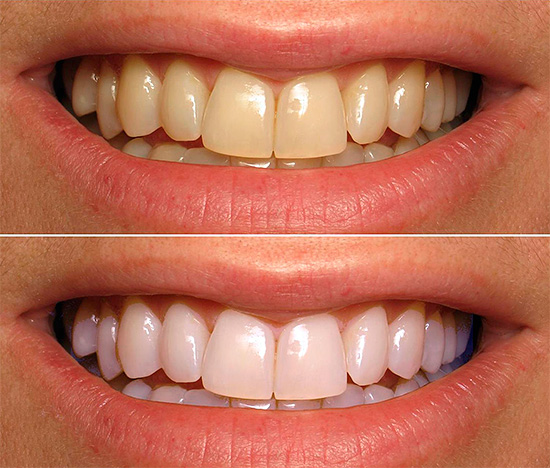
The main disadvantage of this type of whitening is the damage done to enamels, which, however, can be minimized due to remineralization and fluoridation of teeth after the procedure (but it can also become one of the main causes of suffering and suffering in the future). The violation of the protective properties of enamel during the chemical bleaching of teeth is currently one of the main problems that scientists are still trying to solve.
How does professional chemical teeth whitening differ from home-made?
First, the concentration of bleaching agent for professional types of bleaching is significantly higher (usually 30-35%). "Home" concentration - no more than 10-15%. This is due to the fact that at the reception at the dentist there are more options to protect the gums and oral mucosa from aggressive substances.
Secondly, the real result on professional bleaching can be obtained much faster (more often in one visit), and home-made methods (for example, wearing a cap) can take 2 weeks or more.
Thirdly, professional types of bleaching often suggest additional activation of a chemical reaction with devices based on laser, ultraviolet radiation, etc. - to achieve the most pronounced, fast and safe effect.
Dental-controlled home whitening is based on the following principle of operation:
- special acid components pickle enamel in order to ensure its increased porosity and permeability;
- and hydrogen peroxide (or its derivative) decolorizes the colored compounds in the pores of the enamel, as a result of which clarification occurs.
For the safety of this type of teeth whitening, dentists make individual caps for the patient in the molds so that the gel is placed on the teeth during the home procedure, reducing the risks of gum burns.

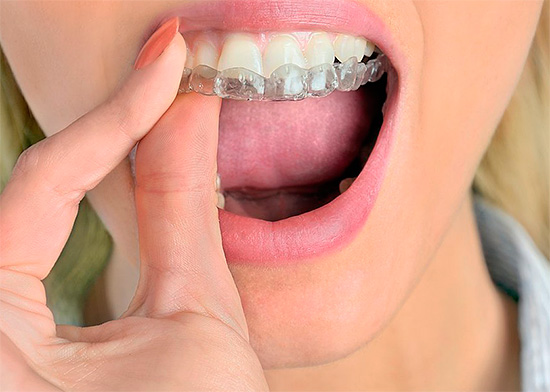
The main plus is reduced harm to enamel (compared to room bleaching of teeth), and a minus - minor whitening indicators, although such methods are quite suitable as a fixing procedure.
Professional and controlled home whitening should not be carried out if there are carious teeth in the mouth,old and unsuitable fillings, plaque and stone, as well as with strong bleeding of the gums against the background of its inflammation in periodontitis. In such cases, it is advisable to first reorganize (treat) carious lesions and replace fillings at the dentist-therapist, carry out professional hygiene of the oral cavity with removal of tartar and plaque, transfer the dentist to a stage of stable remission of periodontitis by a specialist in diseases of the gums and oral mucosa. periodontist, and only then think about teeth whitening.
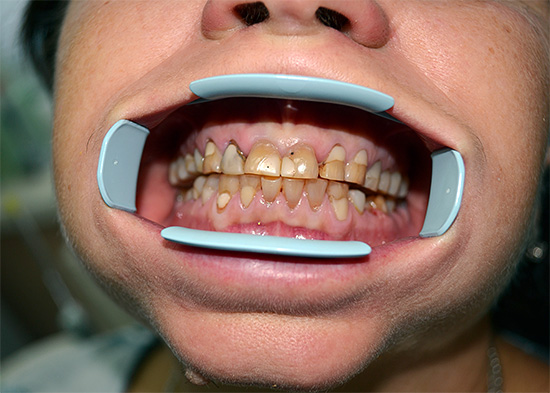
It is interesting
As part of “advanced” whitening toothpastes, you can find carbamide peroxide or even just H2O2: it would seem, here it is - the ideal solution when the peroxide compound will lighten the enamel directly while brushing your teeth. That is, the idea is not only to wipe the plaque from the enamel, but also to discolor the undesirable colored substances contained in the enamel itself.
Well, applying these pastes, you should take into account this nuance. Even for chemical home teeth whitening with a cap (the effect of which is often minimal), many times higher concentrations of peroxide compounds are used than are found in such pastes.In addition, in these pastes there are no strong acids that would prepare the enamel for the procedure and create the low pH of the medium necessary for the peroxide to exhibit maximum oxidative properties.
But how good the idea (and advertising) ...
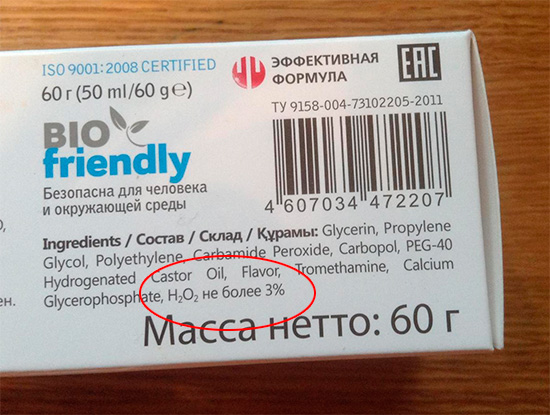
Homemade methods of chemical bleaching
In addition to controlled home teeth whitening with the help of adapted whitening systems, there are also “amateur” options for performing a similar procedure: whitening strips, pencils, drips, etc.
Whitening pencil
A whitening pencil is a tube with a bleaching agent, and for applying a rod of the pencil itself is used, made in the form of a brush, brush or sponge. The concentration of hydrogen peroxide in the composition is insignificant - 5-15%, but this is quite enough to cause chemical burns of the mucous membranes of the oral cavity in case of violation of the safety regulations of the application.
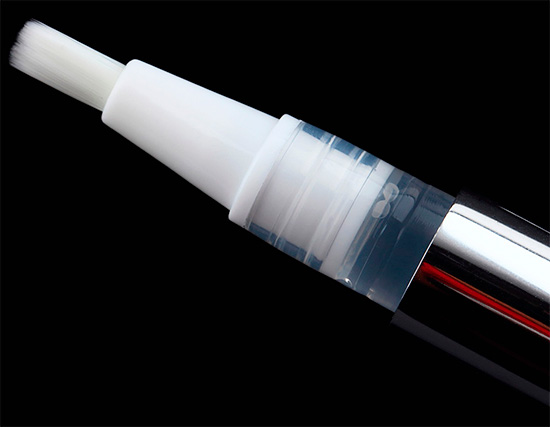
Each person has individual features of the structure of enamel and dentin, as a result of which it is impossible to predict exactly when the undesirable effects of the interaction of hydrogen peroxide with the tooth tissues in the form of increased sensitivity of the teeth (and whether they will appear at all) appear.This can occur after 1-2 procedures, and in some cases in 2 or more weeks.
The principle of using whitening pencils is simple - for this you should:
- rinse your mouth;
- wipe your teeth with a napkin;
- apply gel;
- sit with your mouth open for about 1-10 minutes (depending on the type of whitening pencil - the required time is indicated in the instructions for its use);
- then wash the gel with water.
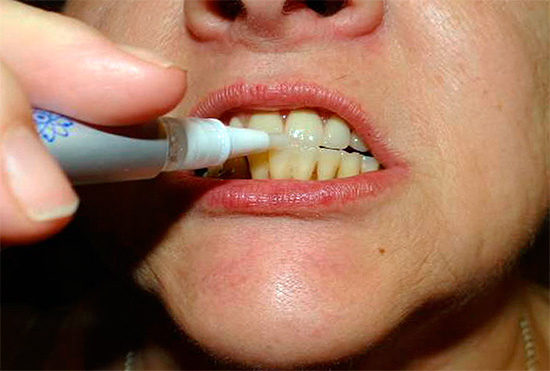
As a rule, the duration of the course is up to 2 weeks (2 times a day). Moreover, the result can be determined not only by the effectiveness of the drug used, but also by the presence of bad habits in a person (for example, smoking, frequent consumption of strong coffee).
Whitening strips
The so-called whitening strips are polyethylene strips with a layer of special composition, usually containing from 6 to 10% hydrogen peroxide. That is, as you already understood, this type of teeth whitening is also chemical.

The set usually offers stripes for the upper and lower teeth. The principle of home whitening with strips is that they are pressed to the teeth for about 30 minutes - at this time chemical reactions occur, leading to a gradual discoloration of the colored compounds present in the enamel.
Usually, manufacturers recommend the use of strips 2 times a day for 1-2 weeks. Side effects are the same as with whitening pencils: the risk of burns of the mucous membranes and the development of increased sensitivity of teeth.
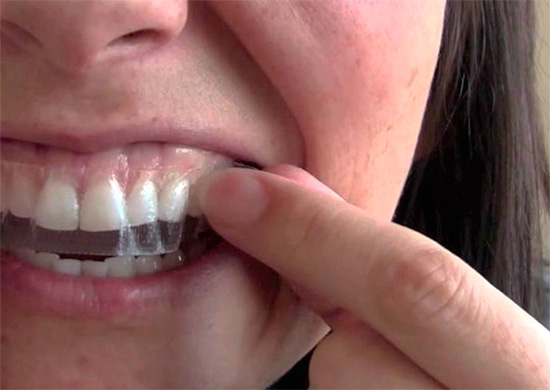
The effect of whitening with stripes may not happen at all: neither in 7 days nor in 2 weeks, and sensitivity, according to numerous reviews on Internet forums, comes to every third. And often it manifests itself not even in pains from cold and hot, but in the form of a strip piercing the aches in the tooth while the strips are held on it - but people still tolerate it.
Feedback:
“I am a lover of coffee and tea, so when I read on the Internet reviews about the whitening miracle strips, like a fool, I rushed to buy them through the online store. As a result, bought a set of Crest Whitestrips 3D White. It was clearly written there that they are great even for sensitive teeth, and my teeth were not very sensitive, so I thought that they would fit.
After the first time I put these strips on my teeth and took off, it seemed as if the smile had become a little whiter, and there was no pain at all. On the second day, I again applied them to my teeth according to the instructions for half an hour.When I took off the strip, I almost fell into a swoon: a piece of gum really tears over the front tooth. Like a skin of sausage, the skin wrinkled and moved away in a thick layer.
When I came to the dentist for an explanation with this problem, she explained to me that this was a serious chemical burn of the gums, as the gel from the strip somehow managed to get under it. As the doctor explained to me, such cases with homemade whitening strips and pencils are not uncommon. Since the root of my tooth was bare, she advised me to make a plastic gum worth 8,000 rubles! And what do you think, people, is it worth risking your gum in order to dump such amount later?
Ksenia, Moscow
Photobleaching of teeth (ZOOM): advantages and disadvantages
Tooth whitening is the technology of desk chemical bleaching, but with the activation of the process by UV light. It is also called the ZOOM technique or “cold” teeth whitening.
In cold bleaching, a hydrogen peroxide gel is applied to the surface of the teeth and is activated by an ultraviolet, halogen, or LED lamp. Peroxide concentrations are usually quite high, on average 25-35%.

Photobleaching is one of the most effective methods, as its technology is specifically aimed at improving results and reducing tooth sensitivity. (by reducing the exposure time). Light emission allows:
- increase the rate of decomposition of peroxide compounds with the release of active oxygen (which, in fact, plays a key role in the bleaching of colored substances);
- allows you to reduce the exposure time of the gel, which, in turn, reduces its negative impact on the enamel.
After splitting the organic pigments contained in the enamel, it becomes noticeably whiter. However, in some cases one procedure may not be enough.
After photobleaching (ZOOM), which can last from 30 minutes to 1 hour, the teeth are fluoridated to prevent their sensitivity.
On a note
Despite the widespread belief that photo-whitening zoom is one of the most benign types of teeth whitening, we must not forget an important point: in many respects precisely because of the high aggressiveness of the compounds used, dentists try to minimize the exposure time of the gels on the teeth to reduce side effects. and they are far from uncommon in the practice of the dentist.
The effect of whitening depends on the characteristics of the enamel and its initial color for each individual person. You should not expect the same effect as in advertising: you are unlikely to blind all passersby with the whiteness of a smile; most often the teeth become whiter by 1-3 tones, which is, in general, a good result.
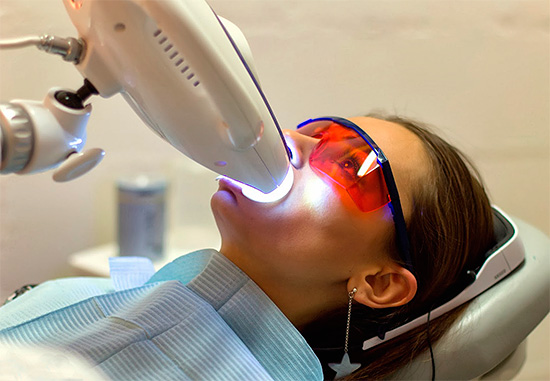
After photobleaching, it is necessary to limit the consumption of coloring foods and beverages (coffee, tea, wine, juices, chocolate, blueberries, blueberries, etc.), and for the first time after the procedure it is better not to use them at all. Such a “white” diet after teeth whitening will allow you to maintain a white-toothed smile for the longest possible term.
Sometimes enamel is bleached with stains, which can be a very unpleasant moment, requiring additional intervention. In addition, in addition to sensitivity to all types of irritants (up to severe pain), after the bleaching procedure, it is often necessary to replace even good fillings in the smile zone, as they become visually yellower than the bleached teeth.
Laser teeth whitening
Laser teeth whitening is a modern and quite effective method of bleaching them, practiced for about 15 years.Numerous studies have shown that in most clinical cases, it is really effective and relatively safe.
The principle of laser bleaching is almost the same as in the photo-bleaching technique: a bleaching composition based on hydrogen peroxide is applied to the surface of the teeth, but the activation of the active substance is produced not by UV lamps, but by a laser. A laser is a kind of catalyst that affects not only the speed of chemical reactions, but also their depth (completeness).
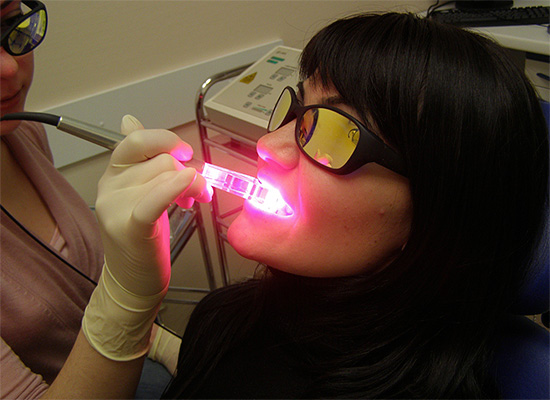
As with other types of professional teeth whitening, the dentist applies gum protectors before the procedure to prevent burns of the mucous membranes, but errors in the work can be found even with a professional dentist. Even in numerous photographs of whitening (before and after) an interesting picture can be observed: before the procedure, the teeth were yellowish, but the gums are pale pink in color, which is the norm. After bleaching, the teeth became noticeably lighter, but hyperemia (redness) appeared on the edge of the gum, which indicates regional burn (which, however, usually passes within one day).
It is interesting
Practicing dentists often use this non-dangerous complication in the form of a marginal burn of the gums to their advantage. Redness of the gums after the whitening procedure is usually not noticed by the patient, but against the background of a strongly reddened gum, the whitening effect looks many times more effective (due to contrast). The teeth could lighten only 1 tone, but the reddened gums will visually emphasize the effect, and the patient is satisfied. After all, the most important thing is the first positive impression.
Laser whitening is not recommended:
- Children under 18;
- During pregnancy and lactation;
- If you are allergic to hydrogen peroxide and other components of the whitening systems;
- In diabetes and some diseases of the pancreas.
These contraindications are characteristic of many other methods of teeth whitening. We can not say that local contraindications for any professional methods of bleaching (except mechanical) are carious teeth, periodontal disease in the acute stage, dental deposits (stones, plaque), old and dilapidated fillings.
Stones and plaque will simply impede the process of chemical bleaching of enamel, and also are themselves a determining factor in the yellowness of teeth.Bad fillings can cause acute pain during the procedure, since hydrogen peroxide can penetrate the microcracks in the seal deep inside the tooth.
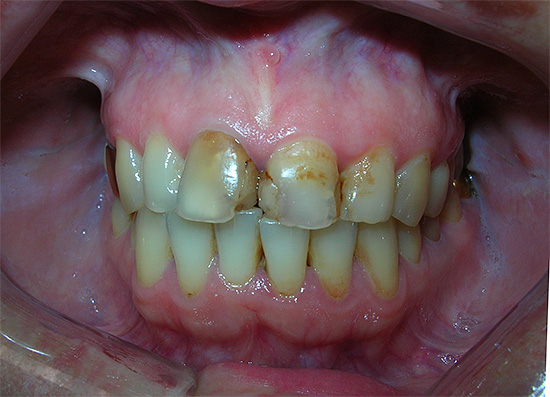
Periodontal disease in the acute stage can be aggravated during the procedure, and it is difficult to isolate the inflamed gums. Increased bleeding gums, including, affects the quality of bleaching.
Carious teeth during whitening is in itself a violation of aesthetics. Why make yourself a snow-white smile, if it will show off 1-2 carious teeth with "black" or even with a carious cavity. In addition, during the application of the gel on carious teeth, a sharp increase in pain is possible, up to an acute attack.
On a note
It is not recommended to carry out bleaching in cases where it is impractical due to the natural natural light yellow color of enamel. Typically, these teeth have a light yellow color in the cervical area, white enamel in the middle and transparent - closer to the cutting edge. Even if such teeth initially do not have increased sensitivity, then after bleaching the maximum it will be possible to achieve lightening by half a tone,but there will be big problems with the treatment of hyperesthesia of teeth from various irritants (cold, hot, etc.). Often, even warm water or food causes pain.
It is important to clearly understand that if the teeth initially have an increased sensitivity, then the bleaching procedure can seriously aggravate the situation.
Intra-channel bleaching
Intra-channel teeth whitening (in other words, endo-whitening) is used if a dead tooth acquires a dark tint due to its staining with substances formed during necrosis of the pulp, with the penetration of pigments deep into the tissues of the dead tooth, or with its staining with filling material.
In such cases, the external impact on the tooth does not allow to cope with the problem. But intracanal chemical bleaching allows you to solve this problem, as evidenced by the many positive reviews.
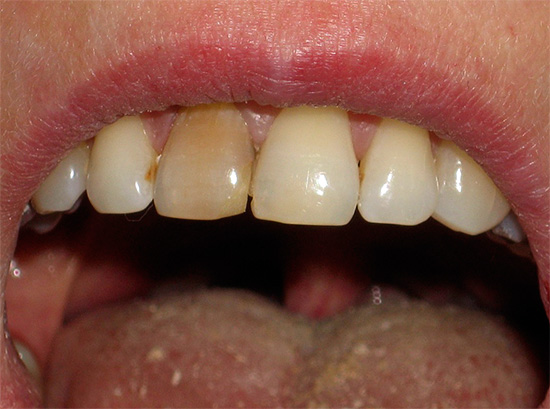
Feedback
“From my youth I always had white teeth, until I treated a couple of caries between the front teeth of one, so to speak,“ specialist ”. Unfortunately, the doctor turned out to be kutelyapy, and I had to change the fillings, and moreover, so that the nerves were first removed from the teeth, and then they made fillings.At first, everything was fine, but after a year and a half I noticed that the front teeth began to change color to a dirty yellow. It began to strain me a lot, so I stopped smiling altogether.
Having been tormented for a couple of years, I began to look for a normal dentist. Some told me that crowns would help, others that laser whitening would help. A friend suggested to me a good doctor who advised intracanal bleaching, since it is from there that the problem with the color of the tooth comes. First, I removed the old filling, put the bleaching agent inside and put a temporary filling. I came to the next visit satisfied: the tooth became much whiter, and it remains only to put a permanent filling ... "
Oksana, Voronezh
A bleaching agent based on carbamide peroxide, sodium perborate or hydrogen peroxide is usually introduced into the channel. Oxygen complex in the process of a chemical reaction discolors the colored compounds in the tissues of the tooth - and this is where the fight against discoloration occurs.
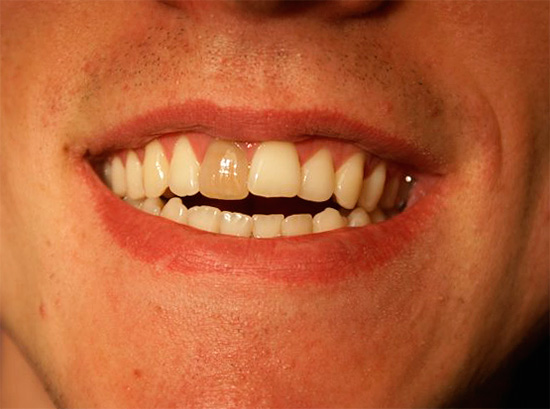
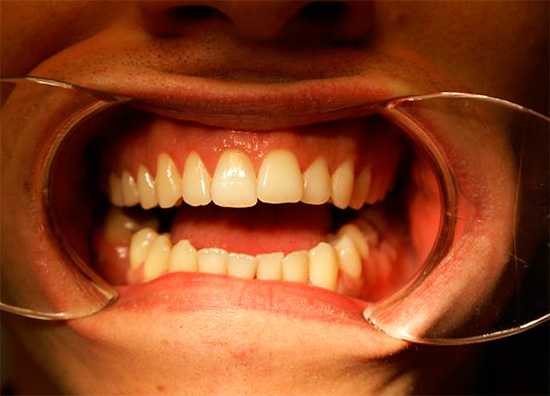
After endobleaching, the tooth acquires its natural color or becomes noticeably lighter. The success of intracanal bleaching depends on the concentration of the whitening gel and the time it is inside the tooth.The main thing here is to get to the dentist for re-admission in time, because if there is a significant time delay, the tooth may become too light.
Traditional methods of teeth whitening: harm or benefit?
Is it possible to whiten teeth on your own at home without using all these pencils, caps and bleaching strips? Well, traditional methods of teeth whitening have been known for a long time, but their comparison with professional systems showed dubious effectiveness and, most importantly, insecurity (in some cases).
Home-based whitening systems controlled by the dentist do not apply to traditional methods. Similarly, bleaching strips at home, caps, pencils, and similar tools are home-developed systems developed by scientists, which are not entirely safe compared to the “grandmother's” methods, but are more or less close to evidence-based medicine and often show certain results.
Next, we consider the truly popular methods of teeth whitening, far from the achievements of modern chemistry.
Charcoal
From the history we can recall that charcoal was the most effective method of teeth whitening in Russia.However, at present this technology of bleaching is hopelessly outdated (usually today people are trying to whiten their teeth with activated charcoal, which is sold in pharmacies in the form of tablets).
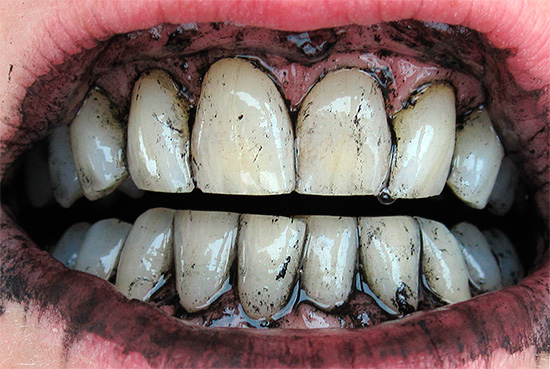
The idea of using activated carbon to whiten teeth is based on its well-known ability to absorb various compounds from solutions (excellent absorbent). For example, if you place a tablet of activated carbon in an aqueous solution of ink and mix, the solution will quickly become transparent.
However, it’s not so simple with teeth: it’s foolish to hope that activated charcoal will pull out pigments from enamel. However, it will be quite possible to erase plaque (including colored) with activated charcoal, although with the same success you can simply brush your teeth with a toothpaste with an average abrasiveness index.
Speaking of ...
In the lineup Splat toothpastes There is a toothpaste containing charcoal - "Splat Blackwood". And this paste is not a classic white color, but an intense black. What can you not do if the consumer really wants ...
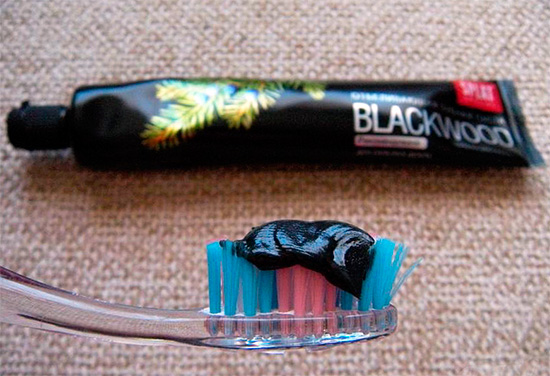
Baking soda - does it whiten teeth?
Baking soda can significantly increase the pH of the environment in the oral cavity by neutralizing acids, however, to whiten her teeth at home will be very problematic.
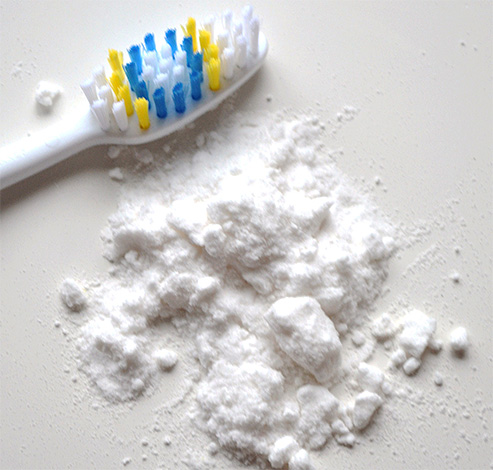
Soda powder mixed with water (or saliva) is of moderate abrasive strength, therefore, if it is too intense and frequent rubbing the teeth, it may well lead to excessive abrasion of the enamel, which in turn will lead to increased sensitivity of the teeth (remember the Air-Flow technology which was described above). Naturally, soda does not discolor the colored compounds present in the enamel, and a small whitening effect can only be due to the removal of the colored plaque present on the teeth, which again is safer to do with a properly selected toothpaste.
Strawberry
Strangely enough, but the use of strawberries is one of the most popular among the "berry-fruit" methods of teeth whitening, practiced by the people.
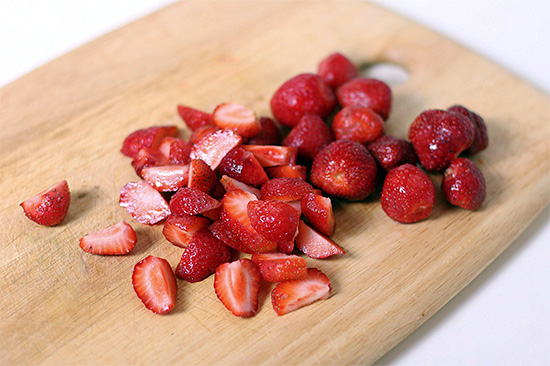
The proposed bleaching recipe is like this:
- It should take strawberries;
- Cut it in half;
- Grind a half in the teeth;
- Leave for about 10 minutes;
- Then brush your teeth with a familiar toothpaste.
At once we will say that it is clearly not worth counting on the pronounced whitening effect of such use of strawberries. However, organic acids, which are, moreover, highly effective complexing agents, are methods of gradually “pulling out” calcium ions from the matrix of tartar, thereby contributing to its loosening and subsequent erasure with toothpaste.
However, with the same success, the long-term and regular action of organic acids will leach calcium from healthy enamel - this can be the cause of caries in the white spot in the smile zone, the problems from which without proper treatment can be much greater than the benefits of such doubtful in general, the procedure.
It is better to just eat strawberries and rinse your mouth - there will be much more benefits for you.
Teeth whitening according to Neumyvakin
Another specific type of teeth whitening is the so-called Neumyvakin whitening.
The recipe is this: it is necessary to add 20 drops of pharmaceutical 3% hydrogen peroxide in 0.5 teaspoons of soda, and then a couple of drops of lemon juice, and then mix the resulting paste with a fleece to rub not only your teeth, but also the gums inside and outside.
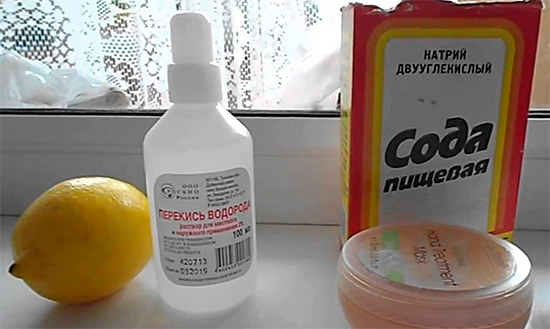
It is believed that this paste not only whitens teeth by removing tartar and plaque, but also heals the gums. There are many fans of this type of bleaching, but is there any effect from it?
The interaction of soda (sodium bicarbonate) and citric acid forms sodium citrate, which has the properties of a complexing agent and is able to firmly bind calcium ions, “extracting” them, for example, from tartar. Soda powder plays the role of an average abrasive force, mechanically cleansing plaque (and partly stone) from the enamel surface. Hydrogen peroxide is traditionally given the role of chemical bleach, decolorizing colored substances that are in the calculus, plaque and tooth enamel.
Thus, in the whitening of teeth according to Neumyvakin, there seems to be common sense.
However, often this meaning quickly turns into “meaninglessness” with illiterate performance in the hands of an unknowing person. For example, if a would-be experimenter has sensitive teeth, there are already wedge-shaped defects in the cervical area, but a slight yellow shade of enamel causes him to frantically rub teeth with Neumyvakin’s paste - in this case the result will be very poor.

Another thing is when a person naturally has enamel, but his teeth are yellow (or even brown in places) from plaque and stone - in this case, Neumyvakin's whitening would be much more appropriate than in the situation described above.
Speaking of ...
Toothpastes containing in their recipe pyrophosphates (complexing agents), carbamide peroxide and medium strength abrasive system (RDA within 75-150) will, in fact, be a more advanced version of the paste prepared according to Neumyvakin.
We hope that the above information will help you make the right decision regarding teeth whitening. If you already have some practical experience in this matter - be sure to leave your review at the bottom of this page.
Interesting video: criteria for high-quality teeth whitening and important nuances of this procedure.
About the dangers of home teeth whitening


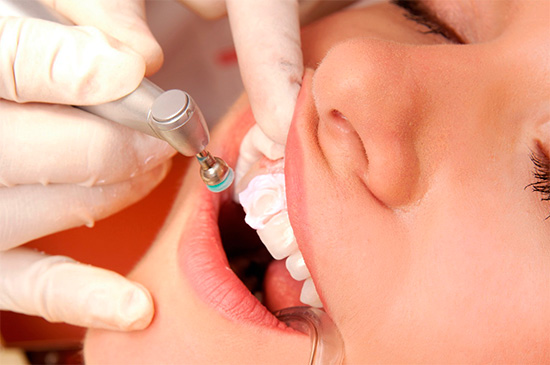
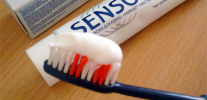
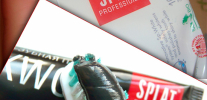
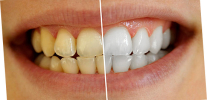
Thanks, very nice article!
Thanks, learned from the article a lot of new and useful information!